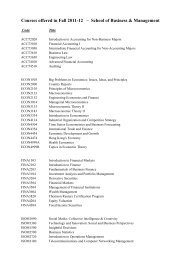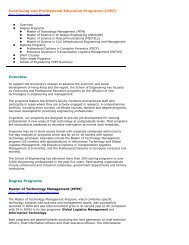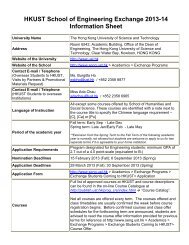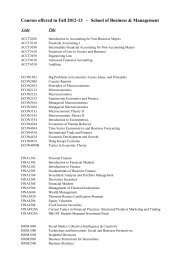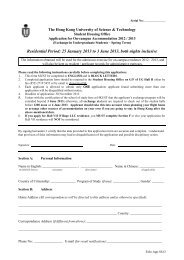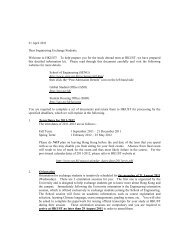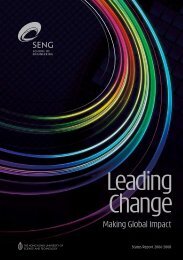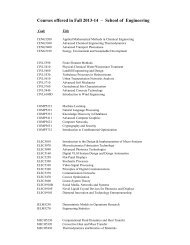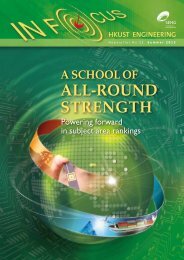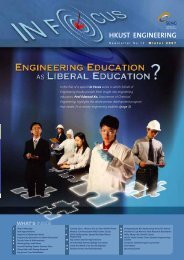pdf version - seng, hkust
pdf version - seng, hkust
pdf version - seng, hkust
Create successful ePaper yourself
Turn your PDF publications into a flip-book with our unique Google optimized e-Paper software.
Inspiring Future Leaders<br />
Holistic Education Initiatives<br />
With the increased emphasis on holistic learning under the four-year curriculum, the School sought<br />
to launch further support measures, foster personal development and encourage students to<br />
engage in enrichment activities in 2009-11 to build awareness of different types of learning among<br />
students and faculty members.<br />
Center for Engineering Education Innovation (E 2 I)<br />
The School identified the critical transition period from school to university and the growing<br />
advisory needs of undergraduates under the student-centric four-year curriculum as key areas for<br />
greater support. One significant undertaking that aims to address both these needs is the Center<br />
for Engineering Education Innovation (E 2 I), established in September 2010.<br />
E 2 I seeks to position the School at the forefront of engineering education practice and research. Its<br />
mission is to design, deliver, and evaluate innovative learning experiences for student and faculty<br />
development.<br />
In student development, E 2 I serves as a one-stop shop in advising first-year students admitted<br />
under the School-based Admission Scheme so that they can make a successful transition to<br />
university life and study, and make an informed decision on their majors. A Peer Mentoring<br />
Program has been in place since 2010 to provide support for incoming students. Peer mentors<br />
are empowered to play a role in the learning of other students by designing purposeful learning<br />
experiences for them. This “Learning to Teach, Teaching to Learn” philosophy is also followed in<br />
other student development programs offered by E 2 I both on and off campus.<br />
E 2 I has been involved in two major initiatives related to the launch of the four-year undergraduate<br />
curriculum. It has been helping to scale up and refine the current system of academic advising<br />
for students. This involves the recruitment and training of peer, professional, and faculty advisors,<br />
along with the provision of physical space that would be conducive to academic and social<br />
interactions among students. The other move is to advance pedagogy through working with faculty<br />
and teaching staff on innovative teaching and assessment strategies in order to maximize student<br />
learning. For example, the Center has offered a series entitled “E²I Conversations on Engineering<br />
Learning and Teaching” since Spring 2011, whereby the School’s faculty and guests gather once a<br />
month during the semester to discuss issues on engineering education informally over lunch. Ideas<br />
are being tried out in new School-sponsored courses and will be applied to other courses. E 2 I<br />
is also engaged in teaching a course in collaboration with the University’s Center for Enhanced<br />
Learning and Teaching for new faculty and one for postgraduate students for the entire university.<br />
Another focus underpinning E 2 I’s work is engineering education research. Most of the research<br />
in this area has been done in Western societies, and much remains to be learned about Chinese<br />
students in the local context. E 2 I has identified many exciting research opportunities and plans<br />
to collaborate with similar centers elsewhere to establish an international network to promote<br />
engineering education scholarship.<br />
14




